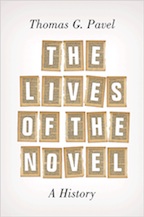By Indira Ganesan
In Thomas G. Pavel’s engaging romp through the history of the Western novel, we know we are in the hands of not only a connoisseur of the craft but an enthusiast. Pavel puts forth the idea that the development of the European novel has always divided itself into genres. The ancient Greek novelists (whose existence might itself be news to some readers, including this one) depicted chaste, steadfast lovers enduring odds to remain together while the Medieval writers, he offers, often “forgot their pledges” due to absent-mindedness or temptations too difficult to resist. By the eighteenth century, heroines flew from villains only to somehow change their pursuer’s nature into something more sublime. One could argue that Austen’s characters had to overcome their own foibles to see clearly who their true love was.
Pavel also suggests they need to see who they themselves are, examine their own prejudice and pride, as it were. Unlike the preening sense of self that that Fielding’s characters present, while being mocked by their creator, Austen, suggests Pavel, founds “the school of empathy.” She uses a small space to reveal errors of judgment and inner contemplation with affectionate humor.
Austen is allotted three pages in this history, while the Brontes, Burney, Eliot, and Woolf are offered much less. Edith Wharton, whose Age of Innocence is a fine example of the presence of community in a novel, is overlooked, as is Willa Cather. This is a history of male novelists, a celebration of Cervantes, Richardson, and Balzac. Originally published in 2003 as La pensee du roman, this volume is bereft of Pavel’s fine intelligence on the European women writers who took the novel to great heights throughout its history.
What is here is the notion that throughout its history, the novel has portrayed “the tendency to idealize human behavior or censure it.” This is certainly true in Clarissa by Samuel Richardson, a voluminous portrayal of a heroine, Clarissa, who tries against all odds to remain virtuous, unaware that the man she seeks help from, Lovelace, only wants to ravish her. At the very center of the novel, he succeeds, but then slowly, his redemptions begins. Lovelace undergoes a change, an action which is as equally idealistic as Clarissa’s nature. In effect, Pavel posits, the novel wants either to “idealize human nature or censure it.” Novelists hold their characters accountable for their vulnerability in love and the desire to mock fate, a line of thought that can be drawn from Cervantes to Martin Amis.
Essentially, we are stuck with our imperfect selves and our imperfect world. Something better is out there, a better form of human nature, and in novels, this ideal is what novelists throughout the ages examine. We read for enrichment as well as entertainment. With this book, Pavel succeeds in bringing back the fun of novels, their dazzle and charm. How refreshing after all the reports of the novel’s demise. One wants to dig up Evelina and Tom Jones, if not Heliodorus’s Ethiopian Story, read the books for themselves, and compare notes.
Novelist Indira Ganesan was inducted into Phi Beta Kappa at Vassar College in 1982. Her books include The Journey (Alfred A. Knopf, 1990), Inheritance (Alfred A. Knopf, 1998) and As Sweet As Honey (Alfred A. Knopf, 2013).




